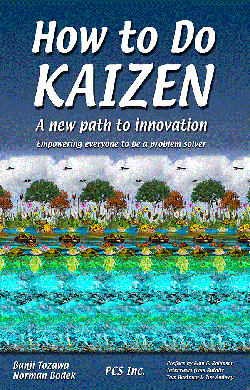 This new book by authors Bunji Tozawa and Norman Bodek, How to Do Kaizen: A new path to innovation (PCS Press, 2010), explains kaizen, the Japanese method of improvement that works from the ground up and on a continuous basis. It directly involves the ideas of those who experience problems first hand, the operators on the shop floor who are the team members and team leaders as well as upper management. Kaizen helps to keep improvements on the immediate level, dealing with situations or problems while they are fresh in the mind rather than some statistic on a chart a month later.
This new book by authors Bunji Tozawa and Norman Bodek, How to Do Kaizen: A new path to innovation (PCS Press, 2010), explains kaizen, the Japanese method of improvement that works from the ground up and on a continuous basis. It directly involves the ideas of those who experience problems first hand, the operators on the shop floor who are the team members and team leaders as well as upper management. Kaizen helps to keep improvements on the immediate level, dealing with situations or problems while they are fresh in the mind rather than some statistic on a chart a month later.
So how do managers encourage employees to share their ideas? What about coaxing the opinions from those whose jobs are directly affected by ideas that have been implemented? How to Do Kaizen answers these questions, from the gathering of ideas, incorporating them, checking results, and sustaining what works. From that, lays a path to further innovation.
…
Add new comment